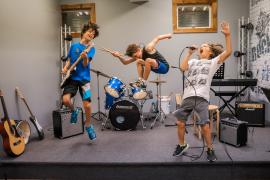This feature article is the first of an ongoing series of articles in Camping Magazine that will focus on inclusion, diversity, and cross-cultural agility to share in our individual communities and out in the world.
This past February, many of us were able to participate in a new educational track at our ACA National Conference in Albuquerque, New Mexico — Camp Includes Me. It was a phenomenal and timely experience as camp professionals from across the country, and the world, came together to focus on diversity, inclusion, and cross-cultural agility.
Session topics included a plethora of subjects — all under the umbrella of inclusion. Sessions on autism, mindfulness, cultural conditioning, proficiency, humility, awareness, racial inclusivity, refugees, transgender, and at-risk youth (just to name a few) were led by camp directors and counselors, educators, and other industry professionals. The sessions identified both big picture and on-the-ground actionable pathways for application through participant reflection, discussion, and active engagement.
We sang, laughed, shared, cried, danced, debated, questioned, listened, reasoned, contemplated, meditated, learned, collaborated, and were challenged and inspired. Many walked away with new connections, ideas, and/or feelings of affirmation in their ongoing work.
On the last day, I facilitated a closing session for a good number of camp professionals who had participated in many of the other Camp Includes Me sessions over the course of the conference. We sat in an organic, oblong circle around our makeshift campfire (a candle) blazing on the floor in the middle of the circle. Sitting in near darkness, each participant holding an inactivated glow stick in his or her hand, we took turns sharing with each other what we had learned, how we felt, and what new actions we were committed to taking as we headed to our respective parts of the world. After a person shared their intentions, he or she would crack the outer casing of the glow stick to activate its light. As each person spoke, the room began to glow brighter and brighter as we held up our small fluorescent lights. It was a small gesture that symbolized our commitment to take all that we had learned about diversity, inclusion, and cross-cultural agility and share it in our individual communities and out in the world.
It was an awesome beginning.
What I learned during the Camp Includes Me track of sessions was that quite a number of individuals and camps are doing a phenomenal job at creating intentional, cross-cultural communities that celebrate diversity and inclusion. They have also figured out ways to navigate the demographic landscape of camp as it continues to shift and to transform to meet the ever-evolving needs of our current and potential campers and staff who may have different ethnic backgrounds, world views, sexual orientations, lifestyles, ages, physical and mental capabilities, religious expressions, economic status, values, and experiences.
So how can we build on the momentum that was created during our national conference — that same momentum that emanates from various pockets of camp communities around the country?
Here are ten things that you can do personally to help widen the circle and increase your inclusion capability.
One: Be Willing to Change Your Mind
Several studies have been conducted on the mind, and scientists are finding that having biases is as natural to the mind as breathing is to the lungs. We all make snap judgments and assessments to keep us safe. But those snap judgments are often made based on faulty or incomplete information. For example, have you ever made a snap judgment about a camper or fellow staff member and later (once you got more information) realized that you were completely wrong? Stereotypes and generalizations are like that. Practice writing the mental stories you create about others in your mind in “pencil” rather than “permanent marker.” In other words, be open to possibly having wrong or incomplete information. Are your beliefs set in stone? Make some mental space to create new perspectives.
Two: Get to Know Everyone
The concept of culture is multilayered and complex like an onion. It is when we pull back the layers, open up, and get to know others that we find we are more alike than different. Everyone wants to be loved, accepted, and respected. When we make an intentional effort to get to know campers and staff who we perceive as different from us, we are less likely to group them in monolithic and homogenous ways. We can then see them and interact with them as individuals rather than as a representative for an entire group. Make connections with others that are more than skin deep. It is variance that adds depth, richness, and excitement to the experience of being a part of our overall camp community.
Three: Take Your Own Pulse
Changing systems and organizations can be overwhelming and frustrating because there are so many moving parts (and people) that are impossible to control. The only way to create what we desire is to start with the only thing we have 100-percent control over — ourselves. It becomes easier to change systemic biases when we become aware of our own individual biases. Be aware of your own internal resistance to inclusion. Each of us must acknowledge our unconscious cultural biases and uncover all the ways those biases influence our judgments, feelings, thoughts, and behavior. No one is immune.
Four: Understand the Diversity Elements You Personally Bring
Diversity comes not only in the form of ethnicity, gender, and language, but it also includes elements that are not so obvious, such as educational levels, economic status, health, religion, values, sexual orientation, thoughts, beliefs, etc. Each of us brings to the table a lifetime of experiences and knowledge, and we each add value because of these differences. How many different cultures are you a member of?
Five: Use Inclusive Language
Greeting a group of girl campers with, “Hey guys” is not meant to be exclusionary, but it could very easily be misconstrued. As a rule, practice using inclusive language all the time. This means talking in a way that does not specify a gender, sex, or sexual orientation unless it is pertinent to the situation. Being sensitive to the fact that cultural membership doesn’t always show on the outside can help us adjust the way we listen and speak.
Six: See Who You Are Not Seeing
There are always people who sit on the fringes of our circles. Initiate meaningful and authentic conversations with others, particularly those who may be quiet, different from you, or overlooked. Look around and see what groups are missing; make a conscious effort to add them.
Seven: Look Back with Purpose
Don’t look back just to reminisce. Reflect on the past with the intention to learn and improve. At many camps, campers and staff join us from all parts of the world bringing with them a rich cornucopia of thoughts, viewpoints, lifestyles, and cultures. To stay relevant we will have to adjust, modify, and recreate our environments to forge new fond memories for and with them.
Eight: Mine the Gap
If there is a gap between the kind of inclusive camp environment you would like to see and the reality of what you currently have, take a step back to objectively “mine” your camp’s environment for gaps, pitfalls, and landmines to inclusion. Add new “miners” in the form of new voices, ethnicities, and perspectives. You just might find the gold that lies beneath the surface.
Nine: Be Aware of Your Cultural Conditioning
Just like a fish that is unable to see the water in which it is swimming, we can be blind to cultural conditioning. What makes cross-cultural agility difficult at times is the complexity of people — and it is natural for us to react and respond to others based on our personal experiences; what others have seen, experienced or heard; what we see in the media; and so on. Thousands of tiny bits of information filter into our minds and shape how we unconsciously respond to others. Being aware that those fragments of information are everywhere helps us to be mindful and more purposeful in our intentions.
Ten: Just Keep Swimming
Know that it will take work. Maintaining the desired transformation we would like to see and experience requires energy. Intentional energy. Creating inclusive camp communities takes time and only happens when we intend for it to.
Hopefully, we will remember the tremendous value that the camp experience affords all who are fortunate to experience it and that we are all connected. Camp is the secret ingredient that when added to almost any life will make it better.
My hope is that you will embrace these tips with the same camp-like enthusiasm that we felt in our last session in Albuquerque. That upon reading them, you will take a moment to reflect on how they make you feel, what new thoughts you are willing to entertain, and what new actions you will to take in the direction of cross-cultural agility. You can light a candle, activate a glow stick or, better yet, use that newfound knowledge to help us light up our camp community and the world.
Niambi Jaha-Echols is a former ACA National Board member, cultural agility strategist, and nationally recognized transformation advocate with over 30 years of experience working with various modalities of creativity. She is the principal and lead consultant for Cross-Cultural Agility Training where she coaches and consults individuals and corporations on issues supporting cultural intelligence. She lives in Chapel Hill, North Carolina, and enjoys uncovering solutions to challenges that beseech the human spirit. Visit ccagtraining.com.
Photo courtesy of Flying Horse Farms, Mt. Gilead, Ohio.




